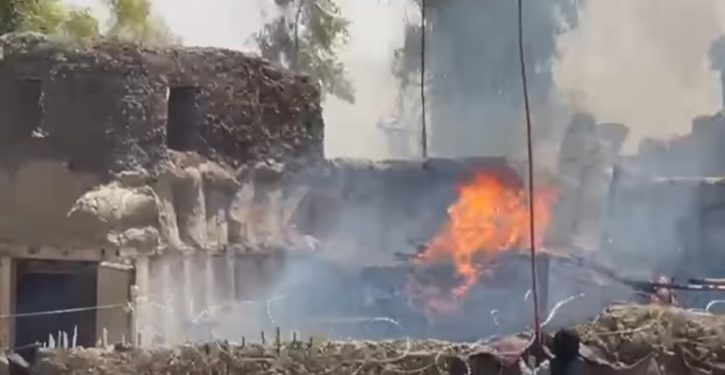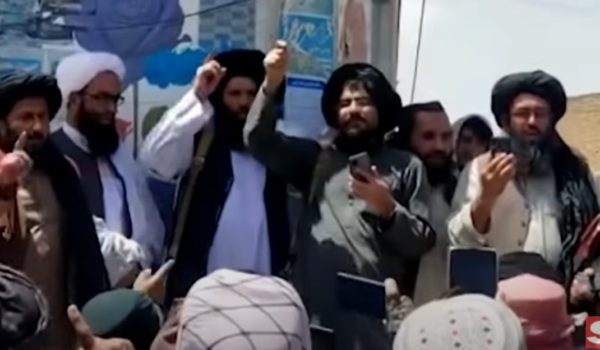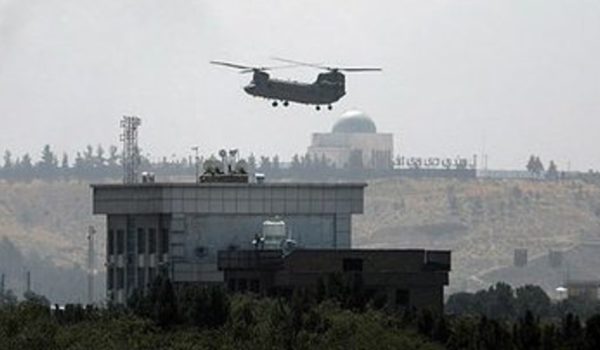
The real question about this move is who could possibly be surprised. The Wall Street Journal reports that “The [Biden] administration has previously said it was seeking to develop what it calls an ‘over-the-horizon’ capability to mount attacks inside Afghanistan if terrorist groups appear there once U.S. forces are gone.”
Readers will be shocked – shocked – to learn that nations around Afghanistan’s perimeter aren’t biting: “The administration has yet to secure access to Central Asian countries it would like to use to improve such an intervention capability, and CIA Director William Burns has told Congress that the removal of American forces would hamper his agency’s ability to gather intelligence within the country.”
It probably isn’t necessary to explain this. But it’s worth noting that if the CIA is concerned that intelligence gathering will be harder in Afghanistan after the U.S. withdrawal (which is a “no duh” forehead-slapper), Central Asian nations next door to Afghanistan will hardly want to be the ones hosting U.S. forces to attack terrorists over the border. If there’s retaliation by the terrorists, including their running mates who are likely to form groups in those adjacent nations, the other Stans will take it in the shorts – and probably with little warning.
Will this presidential election be the most important in American history?
The other Stans are getting an eyeful right now of what it looks like when the U.S. decides it’s time to pivot away from someone’s Central Asian country and its interesting problems. The updates from Saturday 14 August are grim; the Taliban have reportedly taken over in 25 of 34 major provinces, and in terms of major cities now lack control of only the capital, Kabul.
The Taliban now controls 25 of Afghanistan's 34 provinces. Given the fall of Daykundi & current state of play, @LongWarJournal assesses Samangan, Balkh & Baghlan as Taliban controlled. Given what we have witnessed, whatever resistance that may exist is immaterial. pic.twitter.com/6LLJQHu4TG
— Bill Roggio (@billroggio) August 15, 2021
Update: Bill Roggio subsequently posted a side-by-side showing the Taliban’s progress in just the last two days. As he says, “This is what collapse looks like.”
Map of Afghanistan's provinces and capitals, about 46 hours apart. Early Am Aug 13, and now. This is what collapse looks like. pic.twitter.com/ryHpcIsXop
— Bill Roggio (@billroggio) August 15, 2021
‘Nother update: Follow the bouncing ball as additional provinces fall to the Taliban. The speed of this is astonishing.
The Taliban took control of Wardak, Khost, Kapisa, and Bamyan provinces. Only 4 provinces remain (still haven't seen confirmation of Nuristan). It is only a matter of the government surrendering or fighting for Kabul. pic.twitter.com/0veKtbxyt0
— Bill Roggio (@billroggio) August 15, 2021
The key city of Jalalabad, which dominates the surface line of communication (LOC) from Kabul to Pakistan, has fallen to the Taliban, according to multiple news outlets on Saturday.
Taliban take Jalalabad, leaving Kabul as only major city in government control https://t.co/keEmPIjXdo pic.twitter.com/CcZjToAAO9
— FRANCE 24 (@FRANCE24) August 15, 2021
One slice of the recent history here needs revisiting. A map updated at Radio Free Europe/Radio Liberty (RFERL) shows when the Taliban made the big gains in 2021. Note the Taliban holdings as of 1 April 2021, in dark gray, and the territory gained since 1 May 2021, when the current Taliban offensive began. (This map was captured on-screen earlier in the day than Bill Roggio’s Long War Journal map, above.)
U.S. military's predicament (and Afghans') with a couple of maps.
First an overview of areas of control/dispute 14 Aug 2021.
Credit: RFERL
1/3 https://t.co/LPANlgpuOc pic.twitter.com/wxtaDKPpb6— J.E. Dyer (@OptimisticCon) August 14, 2021
The key intervening event, on 14 April 2021, was President Biden’s announcement that the U.S. withdrawal would be completed by 11 September 2021.
Also worth noting: the current drama is the long-foreseen denouement of using Afghanistan as a sniper perch in which to headhunt terrorists, while pursuing a paper-thin policy of pretending that an Afghan National Army had the cultural base to develop into a real, “national” force.
The policy of creating a national army, rather than actually doing much to thwart, deter, and disrupt the Taliban (which has drawn its staying power from safe haven in Pakistan, where it was largely organized originally), was a path-of-least-resistance bandage put over the scab of our real policy: using Afghanistan as a convenient sniper perch.
Rightly or wrongly, that was the policy adopted by the Obama administration in 2009. The Bush administration had not come up with a better one. The credit for the overall outcome in Afghanistan belongs not with one or two presidencies, but with all four.
That said, in the Obama years Biden was reported to be a top advocate of the sniper-perch approach to Afghanistan: doing just enough to keep our own operations viable there, but not seeking a long-term solution that suited the fragmented, heavily tribal conditions in the country. It can truly be said that we never had a realistic vision for a stable Afghanistan that could be left to stand on its own, without U.S. troops as the token of a firm-handed, organizing commitment in Washington, D.C.
An article I wrote in 2013 has held up well, I think:
When Obama and his advisors were deliberating General Stanley McChrystal’s 2009 proposal for a surge, the president decided not to go with the McChrystal strategy of focusing on pacifying – clearing and holding – one part of the country (the south), and eventually expanding a pacification surge to other parts of Afghanistan. Instead, his administration chose consciously to go with “less than that”: effectively, to not pacify Afghanistan at all, but rather to do just enough to keep U.S. forces in country for a while, and be able from there to hunt down and kill transnational jihadists in Afghanistan and Pakistan.
McChrystal (and then-ambassador Karl Eikenberry, formerly the U.S. commander in Afghanistan) warned in 2009 that attempting to merely hold a few portions of Afghanistan, unpacified, would be unworkable. (See an extended discussion here, with links in the comments section as well as the body of the piece.) If we assume that the lives and morale of our own troops matter, and that Afghanistan’s future matters – indeed, if we assume that it matters what we leave behind in Central Asia – McChrystal and Eikenberry were right.
This was foreseeable in 2009, when the Obama administration was first pondering a new strategy. At the time, I referred to the proposal being settled on as “Less Cowbell,” a strategy summed up in these immortal words from the Washington Post: “The White House’s desired end state in Afghanistan, officials said, envisions more informal local security arrangements than in Iraq, a less-capable national government and a greater tolerance of insurgent violence.”
A source quoted by Washington Post offered this soundbite: “The guidance they [the military] have is that we’re not doing everything, and we’re not doing it forever. . . The hardest intellectual exercise will be settling on how much is enough.”

It needed only the formula of top negotiator Richard Holbrooke to set a seal on the U.S. approach and its inevitable outcome. In 2010, Holbrooke was quoted to the effect that we should not expect (or seek) “victory” in Afghanistan, and would have to content ourselves with satisfying criteria that we could label “success.”
“[Y]ou can’t have a settlement with al-Qaeda, you can’t talk to them, you can’t negotiate with them, it’s out of the question,” Holbrooke pointed out – obviously correctly. “But it is possible to talk to Taliban leaders. … What do [critics] mean by win? We don’t use the word win, we use the word succeed.”
Whatever this sounded like to the foreign policy pundits of the West, we can be sure it sounded to the Taliban like this: “If you lot will act like you’re negotiating, we won’t expect victory over you. We’ll just come up with some measuring stick that looks like ‘success’ – until domestic politics or some other change in conditions prompts us to leave.”
Of course the Taliban have been willing to negotiate; to “jaw, jaw,” as Churchill famously put it, rather than “war, war.”
It was more than ten years ago that we talked ourselves into treating the Taliban as a “peace partner” in our effort to “not and say we did” in Afghanistan. We’ve been nourishing the Taliban’s hopes for a decade with our “Less Cowbell” policy and no feasible vision for an end-state. Holding the Taliban in check under such conditions requires a president like Trump, who will probably, in fact, come after you with a blowtorch if you cross his red lines. Biden was a known red-line-ignoring quantity even before he took office.
Hosting the U.S. to hunt terrorists in the neighborhood is thus no longer an appealing franchise in Central Asia. There have been other intervening developments to militate against this expansion, including the deep chill between Russia and NATO and the shutdown in 2015 of the Northern Distribution Network as an alternative, Russia-controlled pipeline for NATO logistics to Afghanistan. Worsening relations between Russia and NATO made the loss of that form of Russian cooperation inevitable after the invasion of Ukraine.
At the same time, the emphasis in the last few years on Russian-Chinese military cooperation, which includes major joint exercises in the Asian precincts of Russia and China, carries clear implications for the power arrangements of the Asian interior. The Central Asian Stans can be in little doubt how that score is trending. No one between the Caspian Sea and Almaty is particularly anxious to get noticed as a troublemaker at this point.
Certainly not for the reward of being left behind at some point by a U.S. executing a broken-field run for the exit.




